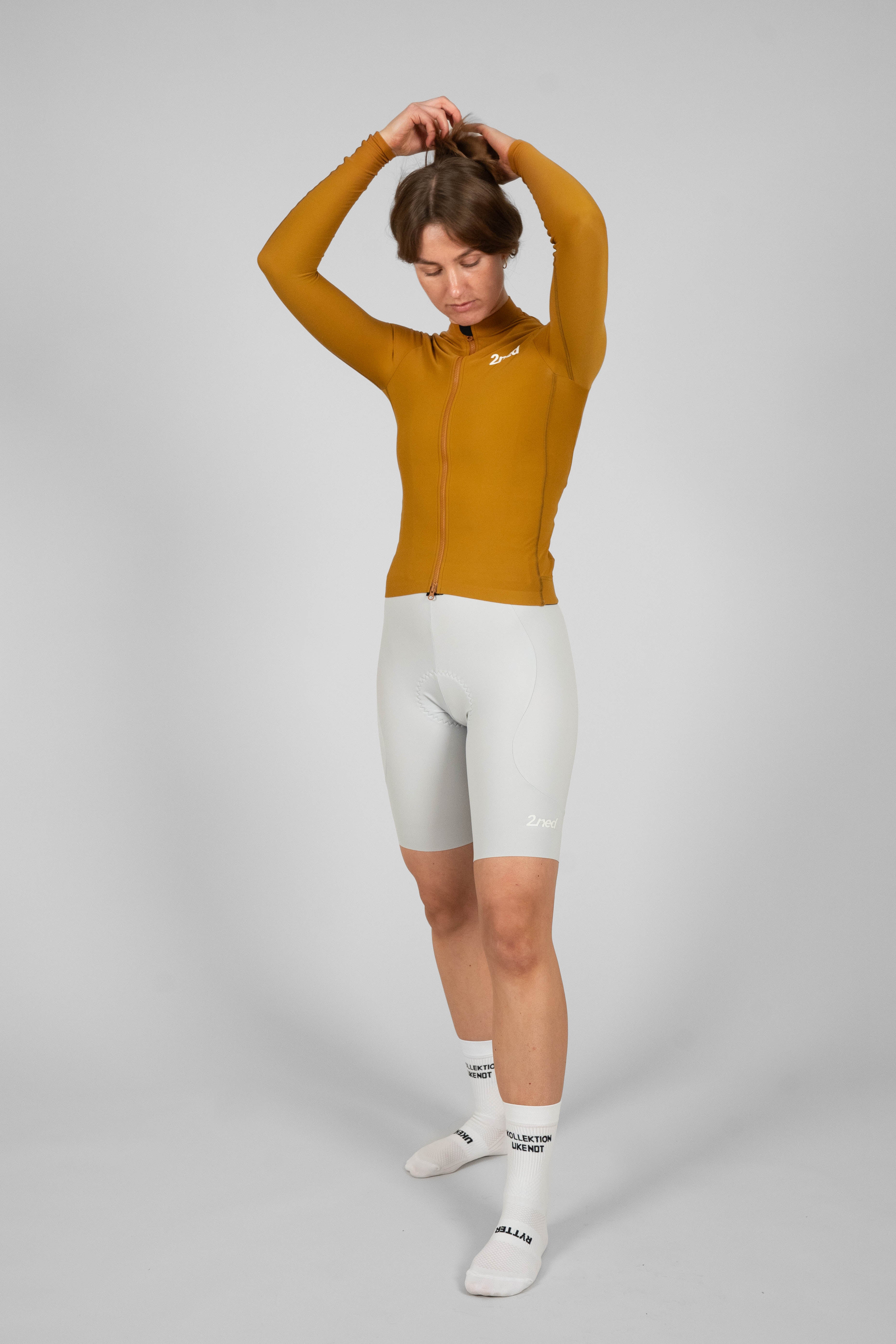|
Written by Malte Therkildsen |
Admittedly, I've been mulling over how to approach this article since Henrik asked me to cover base training among the first articles I would write for 2ned. It's a bit of a paradox because I really have a lot to say, but on the other hand, I also know that my view might not be the most popular at this time, where Zone 2 is almost exalted as the be-all and end-all training zone for elevating your level.
Fundamentally, I disagree with the glorification of Zone 2, but do I think that many of the skilled coaches who preach Zone 2 training are idiots? No, I don't. Am I saying that their words are outright false? No, I don’t. I just think we need to remember not to push the training principles of professionals onto amateurs. Time on the bike is a crucial factor here, and time on the bike is precisely one of the most natural differences between a professional rider's training week and an amateur's training week.
My position is clear, if your goal with your training is to become a better cyclist, and you have between five to ten hours a week to train, then your main focus should not be Zone 2, quite the opposite.
It might be a controversial stance, but fortunately, there is quite a bit of research that supports my view. Research that I will use as a basis for the following chapters, where I will try to bring more nuances to the debate on how best to plan your base training.
But before we dive into that, I want to add that it's important to decide if you even want to get better. There are plenty of cyclists out there who are perfectly content to cycle the same way year after year without any sort of plan. Here, the goal is not necessarily to get better; the goal may rather be to stay healthy and enjoy the sport they love, and there is absolutely nothing wrong with that model.
However, if it is improvements you are striving for, hopefully, the following chapters can inspire you.
Base Training
The winter period is synonymous with the base period, as the perception has become, likely inspired by how professional cyclists structure their season. They use the winter to build the foundation, or "base," for what will underpin their performances in 2024. Many amateur cyclists follow the same model.
The inspiration for amateurs doesn't just stop at the timing of when the base training should occur. Many are also greatly influenced by the content of the professional cyclists' training. This content is often described as Zone 2-focused training. And in these months, "often" is an understatement—it really dominates the conversation.
It's on everyone's lips. You can hardly watch a training video on YouTube, read a training-related article, or listen to a training podcast without it being pointed out how extremely important it is for you to spend a large portion of your time on the bike in Zone 2. So I completely understand if many amateurs think the best thing for them is to do the same.
However, Zone 2 training simply isn't the answer to all your questions, at least it's not the right focus for everyone. Far from it, actually. If you cycle five to ten hours a week, in my view, it's senseless to have a Zone 2-focused training if you want to improve, and that's essentially the thesis of this article.
When professional cyclists spend a considerable portion of their winter training and base period cycling in Zone 2, it's about several things. Firstly, it's about recovery, both between harder intervals during the ride and between training sessions. Moreover, it makes sense that they need to use the lower zones a lot when they're cycling 30 hours a week. Additionally, they have a VO2max that is far higher than the majority of us amateurs, which means they don't need as large a proportion of HIT intervals.
My clear impression is that various coaches and experts forget to mention several factors that differentiate elite riders' training from that of the average amateur or super-amateur when they recommend that we all focus so much on Zone 2 in our winter training.
In the upcoming articles, I will attempt to provide my perspective on what "base training" is and how you should train to achieve your absolute highest level.
I'll also give a few concrete examples of how you can structure your training week, whether you're following the HIT strategy or the Zone 2 strategy.
In addition, I'll try to review some of the factors that make large amounts of Zone 2 training ideal for elite riders, but not for cyclists at lower levels with less time available.
But having so far written in somewhat negative terms about Zone 2 training, I think it's appropriate to start by taking a closer look at the benefits of Zone 2 training specifically.
Benefits of Zone 2 Training
The initial comments on Zone 2 certainly don't imply that it is completely irrelevant. It still needs to be activated, and it remains highly effective and relevant. Generally speaking, any training, regardless of intensity, is a thousand times better than no training.
Moving from the couch to training in Zones 1 or 2 makes a world of difference in terms of your fitness and, not least, your health.
Moreover, Zone 2 is also an effective strategy when we talk about calorie expenditure. I've mentioned the benefits of HIT training for weight loss in previous articles, but if you cycle a lot, Zone 2 also has its relevance in this context.
Of course, you burn fewer calories than in the higher zones, but if your FTP (Functional Threshold Power) is reasonably high, you will also have a decent calorie expenditure at the higher end of Zone 2, and Zone 2 is also more manageable, which can make it easier to cycle longer distances more frequently.
So, if you have the time in your daily life, it would definitely be a good idea to prioritize several hour-long rides during the week where you stay in Zone 2. Additionally, a long Zone 2 ride will not impact your recovery in the same way as a long Zone 3 ride would. Therefore, the need for recovery will be considerably less, which itself is an advantage, as it allows you to fit in more hours and more intense training sessions between your longer Zone 2 rides when planning your training week.
Let's take a more in-depth look at the various positive effects of Zone 2 training.
Zone 2 is Not Very Stressful for the Body
As mentioned, the shorter recovery time is undoubtedly one of the main reasons professional cyclists spend so much time in Zone 2. They need many hours on the bike, and training sessions with a greater focus on Zone 2 make it easier for them to achieve the high volume of hours. Additionally, the Zone 2 days are less stressful than higher-intensity intervals, which ensures that the long, calmer days do not detract from the harder training sessions, which are undoubtedly part of any professional cyclist's training week.
Thus, you can train large amounts in Zone 2 without overloading your body. Therefore, in addition to elite riders, it can also be beneficial for you as an amateur or super-amateur to practice long Zone 2 days.
Low recovery time and less stress also mean fewer risks, which is why Zone 2 is perfect for beginners. With a greater focus on Zone 2, even completely green riders can relatively quickly and safely rack up a decent number of training hours, and more time on the bike will always make you a better cyclist.
The risk of overtraining in Zone 2 is virtually non-existent. For this reason, adding a few extra hours a week in Zone 2 is often the first thing I try to implement to improve the new athletes I start working with. This of course requires having time for more training in one’s daily routine. But if you have the time, it is very easy to manage extra hours in Zone 2 for nearly all athletes and amateurs, because it is simply a comfortable form of training.
Time on the Bike Makes You Better
You don’t need to delve deeply into sports science research, particularly concerning cycling, to discover that there's a strong correlation between the number of hours spent on the bike and the level of performance achieved.
There are several reasons for this, one of which is that a high training volume is perhaps the most effective way to increase the number of mitochondria in your muscles, which I will revisit later. Another reason is that more hours on the bike can likely improve your cycling economy.
In cycling, much depends on the connection between your brain and your muscles. The more time you spend on the bike, the more normal it becomes for your brain and body to cycle, which results in you using less energy across all zones.
Knowing that more hours on the bike make you better, it’s also worth considering and planning your time on the bike. So, decide how many hours you have available and how much you’re willing to spend on the bike without burning out.
If you are motivated to increase your hours, there's undoubtedly something to gain, but it's also crucial to find the right balance in your training program to ensure you do not end up overtraining and thus forced into a break. Here, longer Zone 2 intervals are the optimal filler, ensuring you more hours without drastically affecting your recovery.
Zone 2 is ideal as useful "filler" in your training weeks but should never dominate the entire week unless it's a designated recovery week. You need to ensure that you also activate the higher zones during a training week. If you focus exclusively on Zone 2 in a seven-hour training week, it will certainly not significantly elevate your level unless you're starting from a very low base.
The simple reason we also need activation of the higher zones is stress. Effective training is about stress; you simply need to stress the body to improve. If your week consists only of Zone 2 training, it's not impossible to achieve the right stress in the body—it just requires really many hours. More hours than the average amateur has available.
In fact, you would need to spend between 15 to 20 hours a week to reach a point where you add the right stress to the body. Twenty hours a week in Zone 2 will definitely result in accumulated stress over weeks and months. It will have a positive effect on your physiology, including your vascular system, heart, blood, and so forth. Not nearly what you can achieve with HIT, but it still has an effect, especially if much of your time on the bike is spent at the higher end of Zone 2.
Zone 2 for Recovery
If you're already training very hard two to three times a week, adding more high-intensity interval training (HIT) will in most cases lead to inadequate recovery. For many, this will result in their intense workouts becoming suboptimal, as they can no longer perform at the wattage they are capable of with fresh legs. However, there are a few physical marvels who seem to be able to train hard consistently.
Unless it's a targeted block training, where, for example, you are focusing heavily on increasing your VO2max through intensified HIT training, a good rule of thumb is that you should not have more than two to three very hard training sessions per week. On the remaining days, it would be beneficial to focus more on Zone 2.
The important thing here is time on the bike, combined with having the right freshness for your hard training sessions, so your many hours on the bike don't end up meaning that you can't maintain your watts in your planned intense intervals. Here, Zone 2 training, everything below LT1 (fatmax), is the perfect choice to complement your hard training sessions.
You should of course ensure that your carbohydrate stores are not depleted during this, but otherwise, anything below LT1 allows you to have some really long training sessions between your hard training days without having to worry about your freshness.
More Time in Zone 2 Will Increase the Number of Mitochondria
Research has shown that a large volume of low-intensity training is the ideal way to increase the number of mitochondria in the muscles.
Mitochondrial adaptations are the greatest benefit of Zone 2 training because the number of mitochondria is one of the defining factors that determine how good cyclists we are. Thus, mitochondrial adaptations are something every athlete should strive for.
It's quite simple when you understand what mitochondria do. Specifically, the mitochondria in our muscles are responsible for oxygen uptake, and the better we become at absorbing oxygen in our muscles, the more endurance we have.
Professor David Bishop from Australia has published a lot of research over the last decade showing that there is always a correlation between more hours on the bike and an increased number of mitochondria. High-intensity training also increases the number of mitochondria in the muscles, but it's clear that you cannot maintain high intensity for long enough if you only focus on activating the high zones. However, one of the effects of activating the high zones is that it makes your existing mitochondria function better.
Therefore, it's crucial for your development that you build your program in a way that ensures you get enough activation of the high zones while also activating the lower zones.
Thus, Zone 2 training is very relevant because it is a relatively risk-free zone in terms of injuries, and a zone that can be practiced on the bike for several hours without the fear of overtraining, which ensures more mitochondrial adaptations.
What Makes the Most Sense?
Despite the positive effects of Zone 2 training, I find it difficult to see the rationale in a Zone 2-focused base training for an amateur who has between 5-10 hours of training per week, since the whole concept of base training is precisely to train those aspects of physiology that take the longest to improve.
Yes, by spending many hours activating Zone 2, you will increase your mitochondria in the muscles, but we also know that physiological adaptations such as hypertrophy of the heart and increase in hemoglobin mass take the longest to change.
Hypertrophy of the heart results in increased stroke volume. The heart simply pumps more blood out per beat. Hemoglobin mass is determined by the amount of red blood cells. These two physiological changes are responsible for delivering oxygen to the muscles—not the uptake, which is the responsibility of mitochondria. Both are necessary for a high performance level.
We know that one's VO2max, the maximum oxygen uptake, is almost exclusively determined by how well the body delivers oxygen to the working muscles. Therefore, to increase our VO2max, we need to work on making our hearts larger and increasing the amount of our red blood cells.
These adaptations take many weeks to improve, often several months before a difference can be seen. Even after several years of training, there is still a lot to be gained in these parameters for most people, especially if they have not engaged in much high-intensity interval training (HIT).
Since the adaptations for oxygen delivery take the absolute longest to achieve, it makes much more sense to me to call the vascular adaptations "the base."
We also know that a high VO2max is a necessity for achieving a high level, including a high FTP. This is another rationale for calling it the base.
As mentioned repeatedly in this article, I do not believe that Zone 2 should be completely ditched; it is a good supplement to the harder days on the bike. I just think that your main focus should be on activating the higher zones. Then you can place your Zone 2 days in between the high-intensity days, and perhaps even try to add extra training hours in Zone 2 to your program, and you will surely activate the mitochondrial adaptations.
Example of a Week in a Traditional Base Program
If I'm working with a cyclist who has seven to eight hours a week available for training, and we have collectively determined that traditional periodization works best for him, the following could very well be an example from a winter week in this amateur's training program:
- Monday - REST
- Tuesday - 90 minutes high Zone 2.
- Wednesday - 60 minutes with 12x30 seconds all-out sprint intervals, with 4-5 minutes of easy Zone 1 recovery between each sprint.
- Thursday - 90 minutes, 2x30 minutes in Zone 3 (low to mid Z3).
- Friday - REST
- Saturday - 2.5 hours in Zone 2, including 2x45 minutes high Zone 2.
- Sunday - 90 minutes, 60 minutes time trial at 90%. Push 90% all out, see if you can improve your watts from week to week.
This example is based on the 5-zone model, which is the most familiar and widely used by many.
As you may have noticed, there is quite a bit of intense training, even though it's a plan based on base training with large amounts of Zone 2.
You might also notice that Zone 3 is included in the program, despite it often being referred to as a "dead zone." That debate is another discussion entirely, deserving its own article, but I definitely do not consider it a "dead zone" unless you focus exclusively on Zone 3 week after week.
Since HIT training is not part of this training week, Zone 3 certainly has its justification. If there were two to three days of HIT training in the program, Zone 2 would be a better choice on the days without HIT intervals. The reasoning here would be that your focus should be on maintaining your planned watts on your HIT days, therefore the remaining days would consist of Zone 2, as it is far better for achieving the proper recovery, which we have already established.
What we have also established is that stress in the body is necessary to improve. Zone 3 stresses the body more than Zone 2, so it does not make much sense to ignore activation of Zone 3. Zone 3 training, or training at moderate intensity, increases the formation of new capillaries in the muscles, which improves the body's maximum oxygen uptake. Additionally, you recruit more muscle fibers in Zone 3 than in Zone 2. Thus, there is certainly something to be gained from Zone 3 training.
The sprint intervals on Wednesday also have some important adaptations, including increasing your FTP. The increased FTP is mainly due to two factors.
First, sprint training positively affects your mitochondria. While time on the bike increases the number of mitochondria, sprint intervals make the mitochondria you already have function better. Additionally, there is a neuromuscular gain from sprint training, which simply means that you become better at activating your muscles across all zones.
According to research, one to two sprint training sessions per week will increase your FTP, regardless of the focus of the remaining training days.
Four out of the eight hours in the program are in Zone 2. Therefore, some might be tempted to call it a Zone 2-focused program with 50 percent of the time in that zone. However, I hope you understand my point. The zones offer different benefits, and eight hours of Zone 2 will not shift your level nearly as much as it would if you have the right composition and variation in your training.
Not Opposed to Zone 2, But Concerned About Its Presentation
As you might sense, my issue isn't really with Zone 2 itself; it's an unavoidable part of any serious training program. My concern is more about how it's presented. I've talked to many amateurs who solely ride in Zone 2 during the winter, which isn't optimal for creating a solid "base" for the upcoming season—especially when they don't have enough hours on the bike to sustain such a heavy focus on Zone 2.
The problem is that Zone 2 is repeatedly emphasized during these months, and I understand why amateurs might think they should also practice it in their winter training, regardless of how many hours they have available. The focus shouldn't just be on Zone 2; it should be on the two to three intense training sessions planned around the Zone 2 days. It's these intense sessions that truly elevate your level; you'll get through the Zone 2 days, but they can't stand alone.
In part 2 of this article series, I will delve deeper into why I believe training according to the Reverse Periodization model is better suited for most amateurs. I will also explore why there's a significant difference when a professional cyclist trains in Zone 2 compared to when an amateur does.
Thank you for reading.
If you need help with structured training or testing, you can find a variety of offers at 2ned Training.








